
Browse an alphabetical list of photographs. These historical images portray people, places, and events before, during, and after World War II and the Holocaust.
<< Previous | Displaying results 26-50 of 345 for "Photo" | Next >>
A display advertising the 11th Summer Olympic Games which were held in Berlin, Germany, 1936.
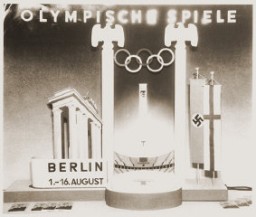
A Dutch survivor of the Ohrdruf camp shows the camp's gallows, which the Germans used to execute prisoners, to US forces (including Generals Eisenhower, Bradley, and Patton). Germany, April 12, 1945.
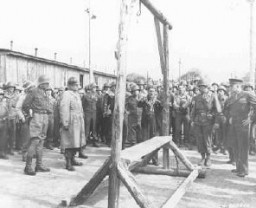
A family stands outside of their wagon while interned in a Zigeunerlager ("Gypsy camp"). In the background, children are crowded around Eva Justin. Justin worked for the Center for Research on Racial Hygiene and Demographic Biology. Schleswig-Holstein, Germany, 1938. During the Nazi era, Dr. Robert Ritter was a leading authority on the racial classification of people pejoratively labeled “Zigeuner” (“Gypsies”). Ritter’s research was in a field called eugenics, or what the Nazis called…
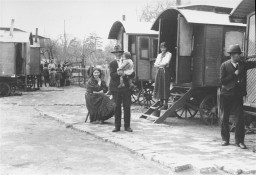
A family of Macedonian Jews in the Tobacco Monopoly transit camp in Skopje before deportation. Skopje, Yugoslavia, March 1943. The Jews of Bulgarian-occupied Thrace and Macedonia were deported in March 1943. On March 11, 1943, over 7,000 Macedonian Jews from Skopje, Bitola, and Stip were rounded up and assembled at the Tobacco Monopoly in Skopje, whose several buildings had been hastily converted into a transit camp. The Macedonian Jews were kept there between eleven and eighteen days,…
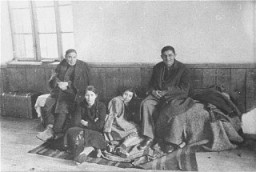
Frieda Greinegger during a family outing to a park in the mid-1930s. Frieda would later spend almost two years in the Ravensbrück concentration camp as punishment for consorting with a Polish forced laborer, Julian Noga. Austria, ca. 1935.
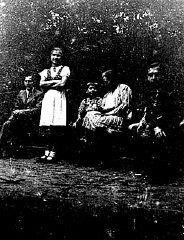
Portrait of a gay couple. Berlin, Germany, ca. 1930. Nazi ideology identified a multitude of enemies and led to the systematic persecution and murder of many millions of people, both Jews and non-Jews. The Nazis posed as moral crusaders who wanted to stamp out the "vice" of homosexuality from Germany in order to help win the racial struggle. Once they took power in 1933, the Nazis intensified persecution of German male homosexuals.
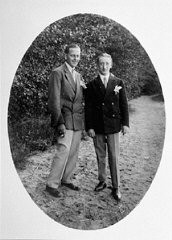
A German Jewish prisoner named Rosenthal pushes a cart in the stone quarry of the Im Fout labor camp in Morocco. The camp housed a group of foreign workers, many of whom fell ill because of poor living conditions. Im Fout, Morocco, 1941-42.
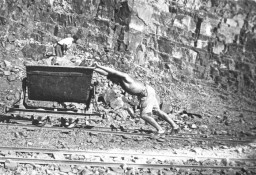
A German soldier stands guard on the eastern front. Soviet Union, February 28, 1944.
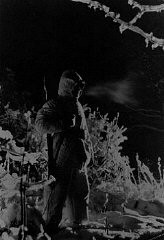
A German soldier stands on a toppled Polish monument. Krakow, Poland, 1940. This statue commemorated the Polish victory at Grunwald over the Teutonic knights in 1410. In accordance with the plans of German occupation authorities in Poland, all physical symbols of Polish national culture were to be obliterated to make way for the "Germanization" of the country.
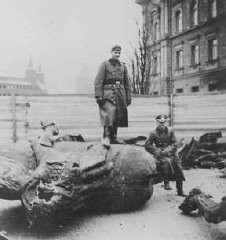
A German teacher singles out a child with "Aryan" features for special praise in class. The use of such examples taught schoolchildren to judge each other from a racial perspective. Germany, wartime.

In Berlin, a German woman reads a copy of the Berliner Illustrierte newspaper, featuring photographs of Mussolini's official visit to Berlin in September 1937.
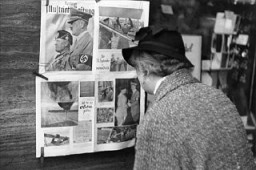
Sofia Karpuk holds a name card intended to help any of her surviving family members locate her at the Kloster Indersdorf displaced persons camp. This photograph was published in newspapers to facilitate reuniting the family. Kloster Indersdorf, Germany, October-November 1945.
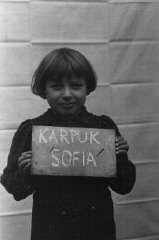
A group of children assembled for deportation to Chelmno. During the roundup known as the "Gehsperre" Aktion, the elderly, infirm, and children were rounded up for deportation. Lodz, Poland, September 5-12, 1942.

A group of children in the Kovno ghetto in Lithuania. This photograph was taken by George Kadish between 1941 and 1943.
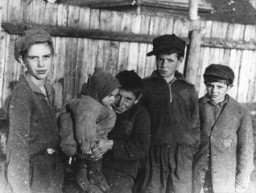
A group of Jehovah's Witnesses in their camp uniforms after liberation. These men were imprisoned in the Niederhagen bei Wewelsburg concentration camp. Niederhagen bei Wewelsbug, Germany, 1945.
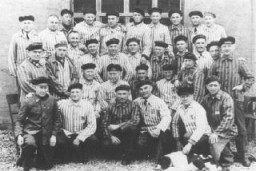
A group of Jewish men on a train platform with French policemen at the Austerlitz station before deportation to the Pithiviers internment camp. Paris, France, May 1941.
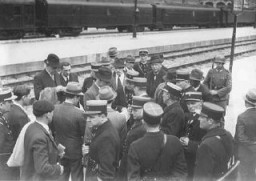
Photograph of a group of Jewish partisans. Sumsk, Poland, date uncertain.
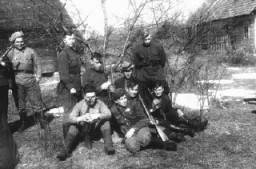
A group of Jewish women in Paris. They are wearing the required yellow badges. Paris, France, June 8, 1942.
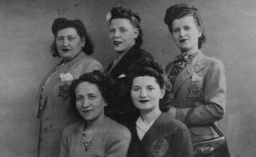
Under SA guard, a group of leading Socialists arrives at the Kislau camp, one of the early concentration camps. Local Social Democratic party leader Ludwig Marum is fourth from the left in the line of arrivals. Kislau, Germany, May 16, 1933.
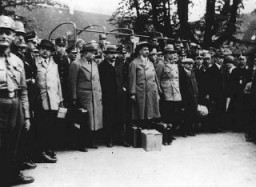
Schoolchildren wait in anticipation for the arrival of the US Ambassador to the United Nations and members of the UN Security Council, who have traveled to South Sudan to underscore their support for the January referendum on the region’s independence. October 9, 2010.
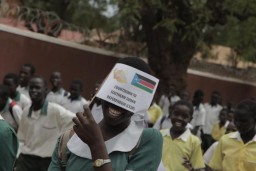
This photograph shows a group of SS officers at Solahuette, the SS retreat outside of Auschwitz. Pictured from left to right: Josef Kramer, Dr. Josef Mengele, Richard Baer, Karl Höcker, and an unidentified officer.
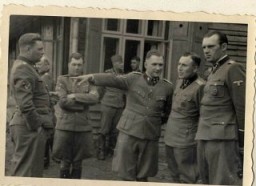
A group of SS officers socialize at an SS retreat outside Auschwitz. Pictured from left to right: Dr. Josef Mengele, Rudolf Höss, Josef Kramer, and an unidentified officer.
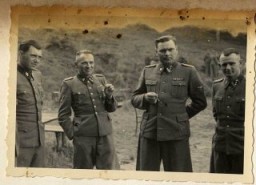
A group of Tunisian schoolgirls wearing aprons. Nadia Cohen is in the first row, third from the left. Tunis, Tunisia, ca. 1930-1935. Nadia Cohen was born on January 17, 1924, in Tunis. Nadia's parents came from Orthodox households, but her father left the yeshiva at the age of seven to study Italian, Arabic, and accounting in a French school. In 1938, Nadia was sent to a boarding school in France. She returned home for a visit in the summer of 1939 but could not return to school that fall due to the…
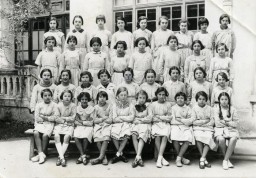
A Hitler Youth ceremony, typical of those conceived by Baldur von Schirach. They aimed to strengthen dedication to Hitler. Members recited verses, sang patriotic songs, and performed "mock funerals" for "fallen comrades." Germany, date uncertain.
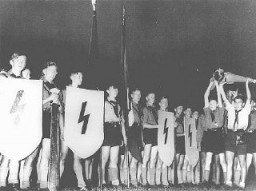
An American Jewish Joint Distribution Committee (JDC) clothing supply center for refugees. Vilna, Lithuania, 1940.
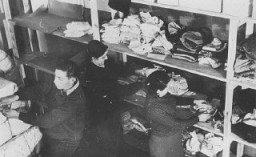
We would like to thank Crown Family Philanthropies, Abe and Ida Cooper Foundation, the Claims Conference, EVZ, and BMF for supporting the ongoing work to create content and resources for the Holocaust Encyclopedia. View the list of donor acknowledgement.